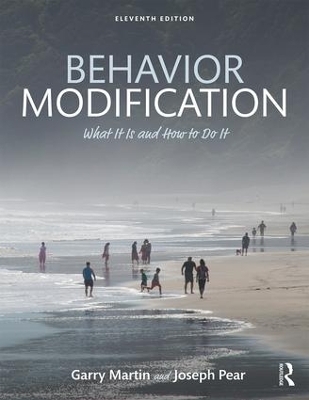
Behavior Modification
Routledge (Verlag)
978-0-8153-6654-6 (ISBN)
- Titel erscheint in neuer Auflage
- Artikel merken
Behavior Modification is ideal for courses in Behavior Modification, Applied Behavior Analysis, Behavior Therapy, the Psychology of Learning, and related areas; and for students and practitioners of various helping professions (such as clinical psychology, counselling, education, medicine, nursing, occupational therapy, physiotherapy, psychiatric nursing, psychiatry, social work, speech therapy, and sport psychology) who are concerned directly with enhancing various forms of behavior development. The material is presented in an interesting, readable format that assumes no prior knowledge of behavior modification or psychology. Specific cases and examples clarify issues and make the principles real. Guidelines throughout provide a ready source to use as a reference in applying the principles.Online resources, including an instructor’s manual, are available at www.routledge.com/9780815366546.
Garry Martin is internationally known for his eight co-authored or co-edited books and 175 journal articles and 106 invited conference presentations in six countries on various areas in Behavioral Modification, including intellectual disabilities, autism spectrum disorder, and sport psychology. He has received numerous honors and awards including induction into the Royal Society of Canada and Distinguished Contribution Award from the Canadian Psychological Assocation. Joseph Pear is internationally known for his work in both Basic and Applied Behavior Analysis. In addition to co-authoring this book with Garry, he has authored two other books and authored or co-authored 12 book chapters, six encyclopedia entries, seven published conference proceedings, two invited newsletter contributions, 60 invited conference presentations and symposia, and 57 peer-reviewed journal articles in diverse areas of basic and applied behavior analysis. He has received numerous awards and distinctions, including being elected a fellow in Divisions six ("Society for Behavioral Neuroscience and Comparative Psychology") and 25 ("Behavior Analysis") of the American Psychological Association.
Preface
Part I: The Behavior Modification Approach
1. Introduction
2. Areas of Application: An Overview
3. Defining, Measuring, and Recording Target Behavior
4. Doing Behavior Modification Research
Part II: Basic Behavioral Principles and Procedures
5. Respondent (Classical, Pavlovian) Conditioning of Reflexive Behavior
6. Increasing a Behavior with Positive Reinforcement
7. Increasing Behavior with Conditioned Reinforcement
8. Decreasing a Behavior with Operant Extinction
9. Getting a New Behavior to Occur with Shaping
10. Developing Behavioral Persistence with Schedules of Reinforcement
11. Responding at the Right Time and Place: Operant Stimulus Discrimination and Stimulus Generalization
12. Changing the Control of a Behavior with Fading
13. Getting a New Sequence of Behaviors to Occur with Behavior Chaining
14. Differential Reinforcement Procedures to Decrease Behavior
15. Decreasing Behavior with Punishment
16. Establishing Behavior by Escape and Avoidance Conditioning
17. Respondent and Operant Conditioning Together
18. Transferring Behavior to New Settings and Making It Last: Programming of Generality of Behavior Change
Part III: Capitalizing on Operant Antecedent Control Procedures
19. Antecedent Control: Rules and Goals
20. Antecedent Control: Modeling, Physical Guidance, and Situational Inducement
21. Antecedent Control: Motivation
Part IV: Putting It All Together to Develop Effective Behavioral Programs
22. Functional Assessment of Causes of Problem Behavior
23. Planning, Applying, and Evaluating a Behavioral Program
24. Token Economies
25. Helping an Individual to Develop Self-Control
Part V: Behavior Therapy for Psychological Disorders
26. Behavioral Approaches to Psychotherapy: Cognitive Restructuring, Self-Directed Coping Methods, and Mindfulness and Acceptance Procedures
27. Psychological Disorders Treated by Behavioral and Cognitive-Behavioral Therapies
Part VI: A Historical Perspective and Ethical Issues
28. Giving it All Some Perspective: A Brief History
29. Ethical Issues
Glossary
References
Author Index
Subject Index
| Erscheinungsdatum | 19.02.2019 |
|---|---|
| Zusatzinfo | 29 Tables, black and white |
| Verlagsort | New York |
| Sprache | englisch |
| Maße | 210 x 280 mm |
| Gewicht | 984 g |
| Themenwelt | Geisteswissenschaften ► Psychologie ► Sozialpsychologie |
| Geisteswissenschaften ► Psychologie ► Verhaltenstherapie | |
| ISBN-10 | 0-8153-6654-X / 081536654X |
| ISBN-13 | 978-0-8153-6654-6 / 9780815366546 |
| Zustand | Neuware |
| Haben Sie eine Frage zum Produkt? |
aus dem Bereich



